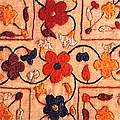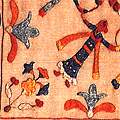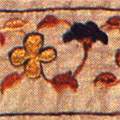Althought embroidered through Himachal the embroidery is associated specifically with Chamba owing to the patronage by rulers of the area. Traditionally, the Chamba rumals were embroidered on square pieces of fabric that were used to cover offerings of food, gifts, offerings to a deity, gifts exchanged between the families of the bride and the groom and other purposes. Chamba rumals have been called ‘paintings in embroidery’ due to the theme being similar to those painted on miniatures. Practiced by women from all strata of Pahari society, the embroidery style differed between the folk and the court styles. The style developed by the court, embroidered by the women of the upper classes and the royalty has now come to be exclusively related to the craft.
Though some themes were similar all else differed as artists trained in the Pahari miniature tradition often rendered the base drawing on which the embroidery was done, often providing the color palette too, for upper class women to follow. Themes centered on the depiction of the God Krishna and his devotees. They included scenes from the Raaslila, Raasmandal , the Ashtanayika, Godhuli – literally the’hour of cowdust’ when Krishna and his cowherd friends bringing the cows back at dusk and other themes, While the folk tradition used vibrant colours the court tradition used subdued, coordinated shades. Traditionally, the Chamba rumals were embroidered on square pieces of handspun and handwoven unbleached fine mulmul cloth The embroidery was done using untwisted silk yarn in a double satin stitch technique known as dorukha, where both sides of the embroidered cloth were identical. The embroidery yarn and stitch is similar to the Phulkari embroideries of Punjab.
Court themes included other subjects relating to the lives of the embroiders and often derived from the wall paintings of the Rang Mahal of Chamba and the Pahari miniature tradition including the royal hunts, the game of dice – chaupad. Products embroidered now include caps, hand held fans, blouses, dress material, table and household linen etc. There has been a revival of this tradition with the Delhi Crafts Council working to create pieces based on the court tradition.
HISTORY & TRADITION: MINIATURE ART IN CHAMBA
The history of the Chamba rumal is linked with that of the rulers of Chamba, with the craft supposed to have come into its own during the reign of Raja Umed Singh of Chamba (1748-68), who patronised miniature artists who had fled from the Mughal courts. After the death of the Mughal Emperor Aurungzeb in 1707, the Mughal court went into decline. Ineffectual rulers and a swiftly fragmenting centre also mean a swift dissipation of the cultural patronage that the Mughals had been renowned for. Artists fled the Mughal courts, seeking shelter and patronage in the courts of regional powers that gained prominence as Mughal power at the centre declined. Thus it came to be that the Chamba king Raja Umed Singh offered patronage to miniature artists from the Mughal courts. This patronage continued under Umed Singh’s successors Raj Singh (1764-94) and Charat Singh (1794-1808).

Even before the exodus of the artists from the Mughal court, Chamba was not unfamiliar with miniature painting. Though the pahari rajas were independent rulers, they were under a larger canopy of Mughal suzerainity that allowed a flow of ideas and techniques from the Mughal court. The sensibility of the pahari miniature – considered the inspiration for artistic, design, and aesthetic expression of the Chamba rumal – was proof of this cultural interaction. The rumals are prolific in the depiction of the wall paintings on the Rang Mahal (Painted Palace), started by Raja Umad Singh of Chamba (1748-68).
PROCESS, TECHNIQUE, & RAW MATERIALS
The traditional Chamba rumal was an embroidered piece of cloth, most often in a square format (hence the term rumal or handkerchief), but also occasionally in oblong formats used during auspicious or ritualistically important occasions to cover ceremonial presentation trays with gifts and offerings. Pahari miniature paintings in existence confirm this by depicting, in several kinds of situations/occasions, gifts covered with embroidered rumals. The rumal was used on a host of occasions: among others, to cover gifts being exchanged between the families of the bride and groom; to cover offerings to gods during religious ceremonies and rituals; and as decorative covers for ceremonial trays bearing gifts to rulers and other high officials.

1. PROCESS
The process of creating a Chamba rumal involved the following steps.
-
The visualisation of the theme to be embroidered.
-
The outlining of the initial drawing in charcoal by a trained miniature
artist. -
The predetermination of a colour palette to be used while
embroidering the rumal. -
The actual embroidering of the rumal by the elite women along the designs sketched in charcoal by miniature artists.
2. CLOTH, THREADS & STITCHES
The fabric used to make the Chamba rumal was hand-spun or hand-woven unbleached thin muslin or malmal. The thread used for the embroidery was untwisted silken yarn, which, in the do-rukha stitch used in Chamba embroidery, has a three-dimensional effect, creating tones of light and shade. This untwisted silk thread – usually made in Sialkot, Amritsar, and Ludhiana – was the same as that used in the Phulkari embroidery of the Punjab.
The stitch used in embroidering the Chamba rumal was the do-rukha, a double satin stitch, which, as its name implies, can be viewed from two (do) sides or aspects (rukh). The stitch is carried both backward and forward and covers both sides of the cloth, effecting a smooth finish that is flat and looks like colours filled into a miniature painting. No knots are visible, and the embroidered rumal can be viewed from both sides. It thus becomes reversible. A simple stem stitch using black silk thread is used to outline the figures. Other stitches like the cross stitch, the button-hole stitch, the long and short stitch, and the herring-bone stitch, as well as pattern darning, were also used occasionally.

3. THE SUBJECT MATTER
There is a strong link between pahari paintings and the embroidery on the rumals. The subject of the embroideries ranged from religious themes, embodying the strong Vaishnava fervour in the pahari regions, to themes from the great epics, the Ramayana, and the Mahabharata. Krishna as an incarnation of Vishnu, and the raaslila or tales from his life formed the core of several depictions: the blue god, Krishna surrounded by his gopis, godhuli (the hour of cowdust, with Krishna and his cow-herd friends bringing home the cows); the Radha-Krishna dalliance, and Rukmini Haran (the abduction of Rukmini) are among the popular themes.
A range of everyday scenes, from court scenes and royal hunts (shikar), to depictions of the popular dice game of chaupad can be found on the rumals. Wedding processions are also depicted. The figures are made with painstaking care and the costumes and ornaments decorated minutely in the style of classical miniature paintings.
Colourful floral and animal motifs – peacocks, snakes, horses, and elephants among others – are often interspersed among the main pictorial elements. The borders of the rumals are almost always a combination of floral and geometrical, usually depicting floral patterns within geometrical settings like parallel lines and squares. The borders are created as a frame for the central picture, and serve to enhance it.
Each rumal is a colourful creation, even though the elite version of the rumal is more subtle in its colour combinations than the more primitive and bold juxtapositions found in the folk style, which commonly use pink, yellow, lemon, purple and green.

DECLINE & REVIVAL
The loss of courtly patronage from the early twentieth century onwards led to a distinct decline in the elite Chamba rumal, leaving only its folk version alive. However, the Delhi Crafts Council is working actively to revive the rumal. As part of this attemp, the Delhi Crafts Council – in March 2002 – started a small centre in Chamba, for training in the art of Chamba embroidery and the production of Chamba rumals. The Council has also organised and supported a six-week exhibition which displayed the work of seven women artisans – a collection of 13 rumals that were reproductions of ancient counterparts housed in museums in Chamba, Delhi, Calcutta and Ahmedabad.
Among the ‘revival embroideries’ were the following:
-
Ganesha: The mythical Hindu god with the head of an elephant is represented with the main figure ‘placed under a scalloped arch, with a green-leaved tree serving as an umbrella’. (Original rumal in the Indian Museum, Kolkata.)
-
Shikar: Representing a pastime common to royalty and feudal lords, shikar depictions represent ‘ a lively scene of movement’, with details that include the ‘variety of prey, the different weapons used, variegated colours for the animals [and the foliage] as well as the patterns of [the] dresses [worn by] the hunters’. (Original rumal in the Indian Museum, Kolkata.)
-
Godhuli: Literally, ‘the hour of cow-dust’, this refers to a rural scene: the cloud of dust that is raised when the cows return home at dusk. Often Krishna and his cow-herd friends are depicted bringing back the cows, a picturisation made more colourful by depictions of women watching, birds flying, nad fish swimming in the water. (Original rumal in the Calico Museum, Ahmedabad.)
-
Radha-Krishna: The depiction of Radha and Krishna on a pavilion is extremely colourful. The pavilion is two-tiered: Radha and Krishna, with attendants are on the first pavilion, while music and other activities are taking place on the ground floor. Depictions of trees, peacocks, and birds indicate that the pavilion is in the garden. (Original rumal in the National Museum, New Delhi.)
-
Raasmandala with Lakshmi-Narayana
- The raasmandala or the various raaslilas of Krishna are popular subjects, especially as they combine colour, activity, and movement. In the rumal that depicts the Raasmandala with Lakshmi-Narayana, a ‘four armed Vishnu and Lakshmi are seated on a double-petalled lotus, flanked by adoring monkeys). Around them dance five blue-skinned Krishnas, interspersed with five gopis. There is a ‘male drummer in the forefront’, and ‘women musicians in ecah corner’. ‘The spaces are interspersed with beautiful flowering shrubs and peacocks’ in vibrant colours. (Original rumal in the Indian Museum, Kolkata.)
-
Parijata Hara: Parijata or kalpa-vriksha, the boon-giving tree, was ‘one of the treasures churned out of the ocean’ in the great samudra-mathan (samudra = ocean; manthan = to churn). The tree was taken by the God of war (and rain), Indra, for his garden. The story depicted by the rumal is that of the theft (haran = abduction/theft) of the tree by Krishna, and the ensuing fight in the heavens between Indra (‘seated on his white elephant’) and Krishna (‘seated on Garuda’). (Original rumal in the Crafts Museum, New Delhi.)
-
Jagannatha: This depicts the divine triad of the Jagannath temple at Puri (Odisha) – Jagannath, Subhadra, and Balaram – with bowls of offerings placed before them. ‘The first floor enshrines the crowned figure of Krishna along with Radha. (Original rumal in the Bhuri Singh Museum, Chamba.)
-
Chaupad: This is a representation of the game of Chaupad or dice that was popular in the Chamba area The X-shaped base on which the game was played is depicted in detail; [f ]our couples, smoking hukkas (pipes) are shown playing the game.’ (Original rumal in the Bhuri Singh Museum, Chamba.)
-
Ashtanayika: Representing the popular subject of ‘nayika-bheda‘ (various moods of the nayika), this has ‘eight drum-shaped panels in two rows’. Each cell depicts the nayika in a distinct mood and in varied surroundings. The moods are depicted through expressions, gestures, and through surrounding motifs, including the peacock and doves. (Original rumal in the Bhuri Singh Museum, Chamba.)

RESOURCE BASES & LINKS
1. IMPORTANT PIECES
-
So far, the oldest dated rumal is a 16th century creation that is supposed to have been embroidered by Bebe Nanki, the sister of Guru Nanak, the founder of the Sikh faith in India. This is now preserved in the Sikh shrine in Gurdaspur in Punjab.
-
A rumal depicting the battle of Kurukshetra – from the Indian epic Mahabharata – is to be found at the Victoria and Albert Museum in London. This oblong piece is supposed to have been presented by Raja Gopal Singh of Chamba to the British in 1833.
2. COLLECTIONS
- Bhuri Singh Museum, Chamba (Himachal Pradesh, India)
- Crafts Museum, New Delhi (Delhi, India)
- Government Museum, Shimla (Himachal Pradesh, India)
- Indian Museum, Kolkata (West Bengal, India)
- National Museum, New Delhi (Delhi, India)
- Victoria & Albert Museum, London (United Kingdom)
3. INFORMATION
- Textual & Photographic Material on the rumal is available with the Delhi Crafts Council.


